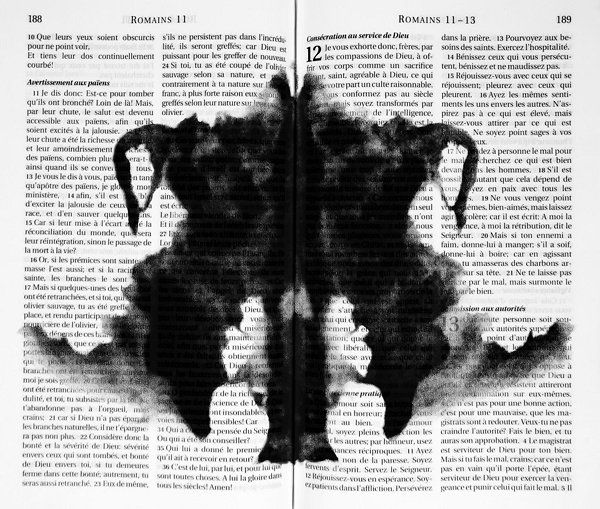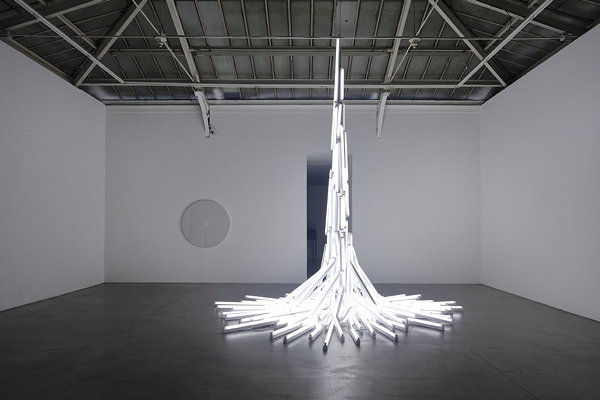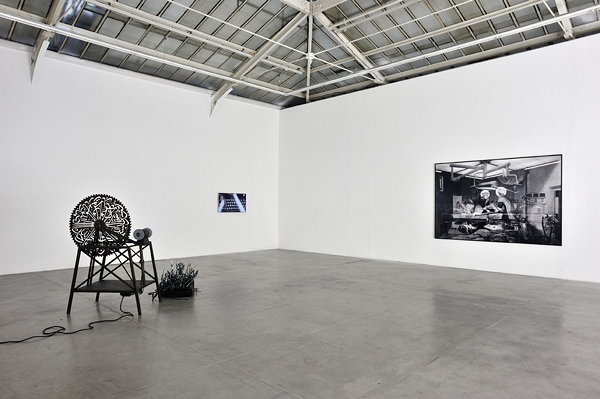|
Censurer un artiste qui travaille sur le poids du rigorisme religieux ne serait-ce pas lui donner raison ? Nul doute que mounir fatmi se soit posé cette question en 2012 lorsqu'une de ses œuvres fut retirée d'une exposition à l'Institut du Monde Arabe à Paris. Fort heureusement la galerie Yvon Lambert présente la fameuse vidéo Sleep al Naim au sein de l'exposition qu'elle consacre à l'artiste. Que voit-on au juste sur cette vidéo ? Un homme ressemblant à Salman Rushdie apparemment endormi qui respire calmement. La caméra le filme en gros plans, elle tourne autour de lui et revient régulièrement filmer son profil éclairé par une lumière artificielle. En effet tout dans cette vidéo est virtuel puisque mounir fatmi n'a pas pu rencontrer Salman Rushdie avant de créer l'œuvre. Allusion au statut de l'écrivain, présence/absence du corps, interdits religieux pesant sur la littérature, autant de thèmes que l'on retrouve dans d'autres œuvres ici. Au-delà de la polémique, on ne peut que noter la beauté plastique presque hypnotique de cette vidéo qui rappelle par moments l'iconographie chrétienne des gisants. Il s'agit ici de la version raccourcie car la version originale dure près de six heures…
En regard de la vidéo une vitrine maculée d'encre noire contient des Bibles et des Corans aux pages recouvertes de taches d'encre. A la manière des tests de Rorschach cette installation invite le visiteur à réinterpréter les textes canoniques des monothéismes : Salman Rushdie avait suivi cette même démarche avec les Versets Sataniques. Les deux œuvres se répondent ainsi parfaitement mais il faut un minimum de connaissances préalables pour apprécier le lien qui les unit.
La deuxième salle contient une sélection d'œuvres assez récentes mais pas inédites. Dès l'entrée une sculpture en tubes blancs attire l'œil : sur les néons sont gravés les versets de la sourate 24 du Coran (La Lumière). Les tubes s'élèvent vers le ciel comme l'âme des croyants transportée par le texte sacré. Ce rapport à la langue arabe se retrouve ailleurs et notamment dans l'autre œuvre centrale de cette salle, la roue de rémouleur. Elle est percée de mots arabes et par terre gisent des lettres arabes en métal : l'ensemble symbolise l'ancienneté de la langue arabe par rapport au formatage opéré par l'uniformisation du texte coranique au 8ème siècle. Derrière l'oeuvre conceptuelle l'humour affleure…
Parmi les autres œuvres deux tableaux hommages à Malevitch composés de câble coaxial blanc sur fond blanc, moins convaincants. Enfin un petit portrait hybride de Salman Rushdie s'affiche dans un coin : mounir fatmi a mélangé le visage de l'écrivain avec ceux d'Anton Tchekov et Joseph Conrad. L'oeuvre issue d'une série plus vaste s'intitule Joseph Anton puisque Salman Rushdie avait choisi ce nom de code lorsqu'il était sous protection policière. L'écrivain pourchassé par les extrémistes religieux s'impose ici comme une présence tutélaire à l'identité mouvante.
Les œuvres de mounir fatmi ne livrent pas facilement leur secret car elles tissent dans cette exposition des liens forts avec l'œuvre et la vie de Salman Rushdie. Il y a en quelque sorte un sous texte derrière ce travail : il faut fournir un effort d'interprétation face à un langage formel qui puise profondément dans ses propres origines…
|
Censorship usually gives artworks a wider audience than the one they were expected to attract originally. This is exactly what happened to mounir fatmi's video Sleep al Naim when it was banned from an exhibition in Paris in 2012. Hopefully Galerie Yvon Lambert chose to show it alongside other emblematic works by this artist who likes to tackle religious issues. So what is this video about ? One can see a man who looks like writer Salman Rushdie asleep and breathing peacefully in a bedroom. The camera draws close to his face and torso, it shows the white sheets of the bed, and always comes back to the man's side filming his forehead gleaming in the light. Everything here is virtual for mounir fatmi didn't manage to meet Salman Rushdie before making the video. The writer's status, the body, the religious laws : such are the themes that permeate most of the works in this exhibition. Notwithstanding the debate around the video one can only feel hypnotised by the plastic beauty it displays : at times it looks very much like a recumbent figure in Christian iconography. It is only a shortened version of the original video which lasts almost six hours…
In the same room stands a glass cabinet stained by black drippings : it contains Bibles and Qur'ans whose pages bear dark spots of ink. They look like Rorschach test shapes and suggest that the sacred texts should be interpreted despite their status : Salman Rushdie himself applied this process when writing the Satanic Verses. The video and the books mirror each other convincingly but one must have some prior knowledge to understand the full meaning of this strange link.
The second room displays a selection of recent works some of which have already been shown before. The most imposing work is a sculpture of neon tubes that immediately attracts the eye : on the white tubes are engraved the verses of sura 24 of the Qur'an (The Light). The tubes rise towards the ceiling like the soul of the believers enthralled by the sacred text. Some of the other works also deal with Arabic language among which the knife-grinder's wheel. Arabic words have been cut out in its disk and on the floor beside it lie metallic Arabic letters. The whole device symbolises the ancient Arabic language prior to its standardisation in the Qur'an during the 8th century. Behind the concept irony emerges.
On the walls one can look at two pictures made of white electrical cable that were intended as an homage to Malevitch's monochromes : they are not as strong as the other works. Finally a small portrait stands in a corner of the room : it shows Salman Rushdie's face mixed with those of Anton Tchekov and Joseph Conrad. It alludes to Rushdie choosing “Joseph Anton” as his codename when he was under police protection. The fugitive writer chased by religious extremists thus becomes a protective figure whose identity shifts continually.
Mounir fatmi's artworks don't disclose their secret easily because they weave strong ties with Rushdie's writings and life. One could say a subtext is always hiding somewhere in this exhibition : an effort is needed to decipher this artistic language that delves deep in its own origins…
Olympe Lemut
Paris, février 2014
|


